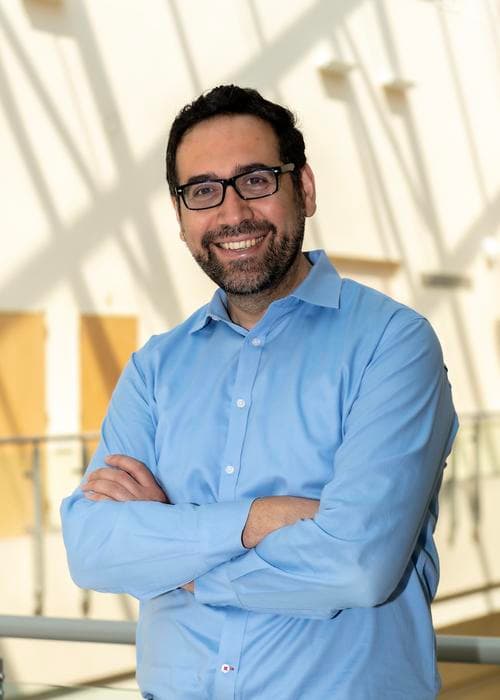BC scientist Emrah Altindis receives $2.5 million NIH grant
Assistant Professor of Biology Emrah Altindis has been awarded a five-year, $2.5-million grant from the National Institutes of Health to advance his research on viral insulins into the understanding of mechanisms related to IGF-1 receptor protein inhibition and its potential applications in cancer treatment.
Altindis said the grant will enable him and the researchers in his lab to learn more about how to use specific viral insulins that mimic human insulin so as to inhibit IGF-1 receptor action, which is increased in a range of diseases, including human cancers.
“I am very excited about our viral insulin project and grateful to the National Institutes of Health for this essential support as we move forward,” said Altindis. “We have made some important discoveries related to unique functions of these viral insulins that are pointing us in the right direction to develop novel therapeutics to inhibit an important receptor and, ultimately, improve human health.”
The Altindis lab has discovered that six viruses mimic human insulin and insulin-like growth factor-1 (IGF-1) and have special peptides, which his team named “VILPs”—viral insulin/IGF-like peptides.
Their research is focused on learning more about how these viral insulins work. Importantly, the lab’s experiments have discovered that only two of these VILPs can uniquely block an important receptor called insulin-like growth factor receptor (IGF1-R), which is overly active in different diseases including breast, ovarian, and prostate cancers, Altindis said.
Scientists have been searching for ways to inhibit this receptor for the past three decades, but have yet to meet with success. With the NIH award, from the agency’s National Institute of Diabetes and Digestive and Kidney Diseases, Altindis and his team are trying to more precisely determine how VILPs can block the IGF1 receptor.
Learning that could lead to affordable and specific treatments that inhibit the receptor for a range of diseases.
Viruses are known to mimic the host’s immune system proteins to manipulate the host during infection. However, the Altindis lab’s discovery identified another mimicry mechanism. In the case of these viral insulins, viruses mimic two important human hormones, insulin and IGF-1, and act through the insulin receptor and IGF-1 receptor. Insulin regulates cell metabolism, and impairment of insulin receptor signaling causes insulin resistance and type 2 diabetes. On the other hand, the IGF-1 receptor stimulates proliferation and cell growth, and any impairment is related to growth disorders and uncontrolled proliferation.

Emrah Altindis (Photos by Lee Pellegrini)
“In the last six years, we have shown that these VILPs can bind and activate the human insulin receptor and IGF-1 receptor,” Altindis said. “Unlike others, two of the VILPs we identified have a unique function: binding and specifically inhibiting the IGF-1 receptor without affecting insulin receptor function.”
Insulin receptors and IGF-1 receptors are very similar in their structure. Therefore, the challenge for Altindis and his fellow scientists has been trying to stop the cell proliferation triggered by IGF-1 by inhibiting IGF-1 receptors without affecting insulin receptor signaling.
Using laboratory models, the Altindis lab will investigate how VILPs interact with IGF1R using advanced techniques, including CryoEM imaging and TurboID labeling. In addition, they will use phosphoproteomics to understand the unique signaling events stimulated by the VILPs. Additionally, experiments will explore the effects of VILPs on IGF-1 signaling and growth in different tissues. Finally, Altindis said the team should be able to determine the effects of these VILPs on cancer cell proliferation in the lab focusing on breast cancer and in related mouse models.
“To our knowledge, VILPs represent the first potent and specific peptide inhibitors of the IGF-1 receptor,” Altindis said. “In this project, our focus is to understand their mechanism of action. Addressing this question will guide us in developing even more effective inhibitors of the receptor.”
Altindis said there is an urgent need to develop potent, specific, and affordable IGF-1 receptor inhibitors to treat IGF1R-related cancers and other diseases like Graves’ disease. Ideally, these inhibitors could be used in combination with other therapies to treat cancer in humans. He believes the project has the potential to impact both the basic understanding of the IGF-1 receptor action as well as lead to the development of novel treatment approaches for breast cancer.
“The challenge lies in translating these findings into practical treatments for diseases,” Altindis said. “This study lays the foundation for future research and clinical developments in the field of IGF-1-related disorders. We hope to generate significant new insights into our understanding of IGF-1 signaling and inhibition that will eventually lead to the design of inhibitors that can be used to treat human disease.”
Altindis said the NIH grant is the result of collaborative work with peers, including Indiana University’s Richard diMarchi, Jiri Jiracek of the Institute of Organic Chemistry and Biochemistry, in Prague, Nicholas Kirk of Walter and Eliza Hall Institute of Medical Research in Australia, and the University of Massachusetts Chan Medical School’s Jason Kim. He also acknowledged Joslin Diabetes Center and Harvard Medical School Professor C. Ronald Kahn, his postdoc supervisor, for introducing him to the insulin/IGF field in 2014 and to fellow researcher François Moreau.
“I also want to express my gratitude to all members of my lab who have been very supportive and productive in the last five years at BC, especially our former postdoc Martina Chrudinova, who did extensive work on this project,” Altindis said. “A big thanks to our Core Facilities at BC, administrators, and colleagues in the Biology Department and the University for their extensive support of our research.”
